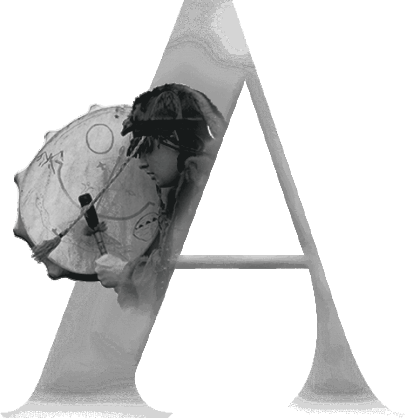The meanings of ancient drawings
on shamanic drums
on shamanic drums
The outer surface of drum among the peoples of South Siberia was divided vertically into three parts, symbolizing the three spheres of the universe. The upper part depicted the sky with celestial bodies, a rainbow, clouds, and the Milky Way. On the left side, the sun, called "the mother," was placed, and on the right side, the moon, called "the father". This placement of the sun and moon reflected the summer time, as the shamans traveled through the sky from spring to autumn until it "froze". Star patterns helped navigate in space during rituals. Below the celestial sphere is a transverse strip representing the land inhabited by humans. A jagged line in the middle of the strip symbolizes mountains. In the lower field of the drum, which represented the underworld, creatures living in it were depicted.
Human figures placed below the horizontal line, holding hands, represent women known as "mountain blond maidens" who "distract" evil spirits from the shaman when he loses strength and needs their help. The snake and frog depicted at the bottom of the drum are considered the foundation of the world. Another notable figure is that of a rider, painted in red at the top of the drum. These riders are benevolent spirits who protect people and shamans; they "ride" on horses dedicated to them by the people during special ceremonies.
Human figures placed below the horizontal line, holding hands, represent women known as "mountain blond maidens" who "distract" evil spirits from the shaman when he loses strength and needs their help. The snake and frog depicted at the bottom of the drum are considered the foundation of the world. Another notable figure is that of a rider, painted in red at the top of the drum. These riders are benevolent spirits who protect people and shamans; they "ride" on horses dedicated to them by the people during special ceremonies.

Khakass drum
The Kets' drawings on the outer surface of the skin depicted the universe with heavenly bodies and the figure of a shaman in the center, and the drawings on the shell were interpreted as the earth with dwellings, deer, and people.

The Ket drum
This Ket drum has a border that "encircles the drum, except for a small section at its bottom. This place signifies the entrance to the underworld. The border consists of two parallel stripes intersected by six diagonal transverse lines grouped in twos, threes, or fours. The number of transverse lines on each side of the drum is seven. These are the "seven heavenly rows". Beneath them, it is evidently implied, are seven layers into which the Kets divide the sky. In this case, the other seven lines must also signify the seven celestial layers or the seven worlds, according to the beliefs of the Ket shamans, existing in constant darkness.
Inside the inner circle there are seven semicircles representing "seas". Six seas are inhabited by fish, but only one fish is depicted in each of them. The seventh sea is "stagnant" or "empty": it contains water that is too hot for the fish to tolerate; it is somewhere in the south.
In the upper part of the drum, luminaries are drawn: the sun on the left and the moon on the right. The sun looks like a circle intersected by four lines whose ends extend beyond its boundaries. These are sun rays. On the end of one of them sits a bird. There is a small circle in the center of the circle. The moon is represented by a semicircle with five radiating rays; birds are depicted on the ends of the four rays.
The center of the drum is occupied by a large figure of a person, interpreted frontally and strictly linearly. His abdomen is swollen. His legs and arms are bent, and fingers are marked on his hands. The face is depicted as a circle, with eyes and mouth marked by lines. Five long lines with birds on their ends indicate, according to the Shaman's words, "the thoughts of the shaman". The "thoughts," evidently, are imagined as flying like a bird. To his right is a small figure of an elk.
The painting as a whole depicts the universe or, in other words, "all lands".
Inside the inner circle there are seven semicircles representing "seas". Six seas are inhabited by fish, but only one fish is depicted in each of them. The seventh sea is "stagnant" or "empty": it contains water that is too hot for the fish to tolerate; it is somewhere in the south.
In the upper part of the drum, luminaries are drawn: the sun on the left and the moon on the right. The sun looks like a circle intersected by four lines whose ends extend beyond its boundaries. These are sun rays. On the end of one of them sits a bird. There is a small circle in the center of the circle. The moon is represented by a semicircle with five radiating rays; birds are depicted on the ends of the four rays.
The center of the drum is occupied by a large figure of a person, interpreted frontally and strictly linearly. His abdomen is swollen. His legs and arms are bent, and fingers are marked on his hands. The face is depicted as a circle, with eyes and mouth marked by lines. Five long lines with birds on their ends indicate, according to the Shaman's words, "the thoughts of the shaman". The "thoughts," evidently, are imagined as flying like a bird. To his right is a small figure of an elk.
The painting as a whole depicts the universe or, in other words, "all lands".

Drawings on the shell of the Ket drum
1, 2, 16 — man; 3-5 — deer; 6, 13 — shaman's dwelling; 7, 12 — shaman's staff; 8, 11 — dwelling; 9, 10 — camp; 14, 15 — dogs
+79221343011 Whatsapp, Viber, Telegram, Signal
info@ahamkara.org
Follow Ahamkara on:
https://ahamkara.teachable.com/ - Online Shamanic School
https://www.facebook.com/ahamkara.eu/notifications... - my Facebook
https://www.instagram.com/ahamkara.eu/ - my Instagram
info@ahamkara.org
Follow Ahamkara on:
https://ahamkara.teachable.com/ - Online Shamanic School
https://www.facebook.com/ahamkara.eu/notifications... - my Facebook
https://www.instagram.com/ahamkara.eu/ - my Instagram
